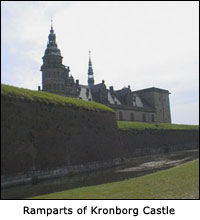
The ferry ride from Helsingborg, Sweden, to Helsingor, Denmark, was only a short, half-hour trip. However, full amenities were on board! We were in the dining room eating a veggie dish of boiled potatoes with gravy and green beans when we looked out the ferry window to see this castle passing by!
Hamlet's Castle
Sally nearly choked on her potato as she scrambled up on deck. Kronborg, Castle – also known as Hamlet's Castle because Shakespeare wrote about this magnificent castle in his famous tragedy – is impressively situated at the entrance to the harbor. It has been greeting sailors arriving to Denmark since 1574. And now, of course, it is a popular tourist destination as well as home to many theatrical productions, including Shakespeare – of course!
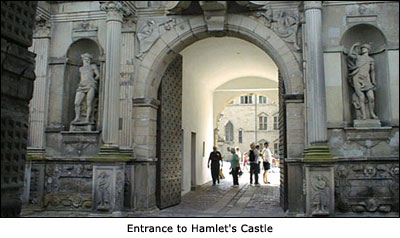
Complete with moat, draw bridges, towers, courtyards and even a dungeon, the castle was an awesome sight. After seeing the dungeon, and visualizing the prisoners reaching their bony hands and fingers through the bars for a scrap of moldy bread and a cup of water, we headed over to the castle cafe for lunch! Our freedom is a blessing of the gods.
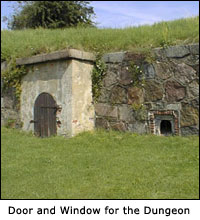 |
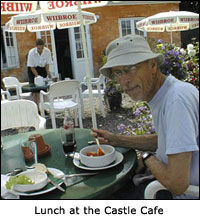 |
The town of Helsingor, established in 1231, is a delightful small town with many walking streets, outdoor cafes, art galleries, and flowers everywhere. And, of course, everyone riding bikes. We decided to make this our home base and take the half hour train ride to Copenhagen rather than drive. Visiting these small towns, with easy access to the city via public transportation, gave us insight into why the Danes love their country.
Louisiana Museum of Modern Art
The world famous Louisiana Museum of Modern Art (Museum for Moderne Kunst) is housed in a former estate overlooking the sea south of Helsingor on the way to Copenhagen. The museum is unique in the way it displays the art inviting the viewer to wander through its halls and rooms with floor-to-ceiling windows or to stroll out into the gardens for an inside-outside experience.
We saw sculptures by Allberto Giacometti, Henry Moore (Bill's favorite) Jean Miro and Alexander Calder (Sally's favorites). Later we saw the same Miro statue in the Pompidou museum in Paris. It was out on a deck (with the Eiffel tower in the background) covered with shade cloth and inaccessible to the public. Perhaps Miro cast more than one statue from the same mold. Isn't it great that this masterful work can be seen by so many people in more than one place.
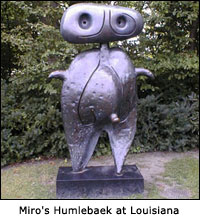 |
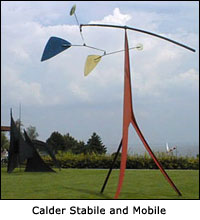 |
We took a picture of these two Calder sculptures side-by-side, set on the grass overlooking the ocean. Sally remembered seeing a book about Calder, showing him at work in his studio. The place was a mass of chaos and clutter. Metal, blow torches, wires and cans of paint were scattered everywhere. And out of that chaos he created these.
This artist is truly a creative genius who had full access to his intuitive faculties. Calder is also well known for his "Circus" of small wire characters that move; a lion that roars, a trapeze lady that swings, and a belly dancer that gyrates her hips and similar delights for the eye to behold. These are further examples of his creative outpouring.
The children's room at the Louisiana was in full swing as young sculptors molded their art treasures. The materials, simply laid out on a table, invited the kids to create. There was very little instruction given, yet the creativity flowed in this inspirational place. The spike-head baseball player was one of Sally's favorites. The children's work suggests that we are born with an innate intuitive sense.
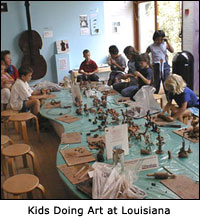 |
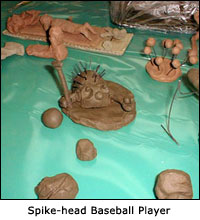 |
Walking and Biking in Denmark
Here's one reason why Denmark is a favorite place to live. Pedestrian and bike trails are everywhere. Bikes on one side; walkers on the other. Bill's bicycling barber, back home in Santa Cruz, would love this. On the other side of the hedge was a narrow road for cars. Given an 180 percent tax on car purchases, bicycles are encouraged!
Imagine that! A place where biking and walking are a part of daily life. It's a quiet, slower pace that's good for the spirit. People are actually touching the earth with their feet. Keeping with the mood, we took the train into Copenhagen and let our feet do the walking. What a great way to see this old/modern city. We sat in the central square to look at our map and orient ourselves. It was Saturday and a farmer's market was going on, and kids were playing basketball.
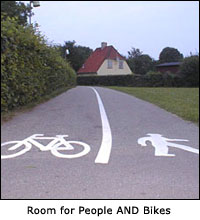 |
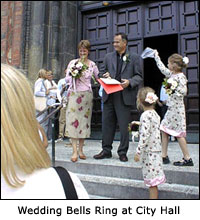 |
We happened to look up to see the Philips weather barometer change as the golden girl with an umbrella slowly emerged, telling us rain was likely. No problem, we had an umbrella. We wandered over toward City Hall just in time to see this smiling bride and groom coming out. As we watched, another couple emerged; a few minutes later, another, and so on. Couples in Denmark seem to take pride in being married in their hometown city hall.
Art Fairs and More Weddings
We headed down a side street, toward the University to see what we could find. Suddenly a courtyard opened up, and we discovered that we had stumbled onto Copenhagen's annual Art's and Crafts fair, The Kunsthandvaerker.
Some of the best hand work in Copenhagen was on display and for sale. Weavings, ultra-modern porcelain, painted fabrics, hand-blown glass and contemporary jewelry. Artist Maren Kanzler's "creatures" were Sally's favorite for sheer creativity and whimsy. She was reminded of creating characters from tree trunks with her granddaughters in Alaska.
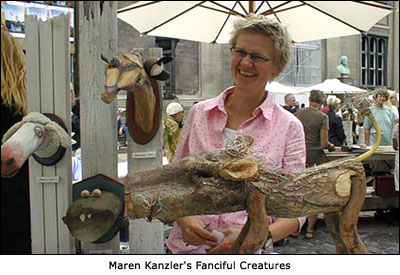
On a stroll along the canal toward the palace, we spotted another wedding party. This time, all were in formal dress, including the guests. They lined up along the canal. "Was the wedding about to start?" we wondered. Soon a barge arrived and all climbed on board. That was a challenge in high heels, long dresses and tuxedo tails! We figured it was a wedding dinner cruise through the canals of Copenhagen. We tried to sneak a photo, but – really – how ugly American did we want to get!
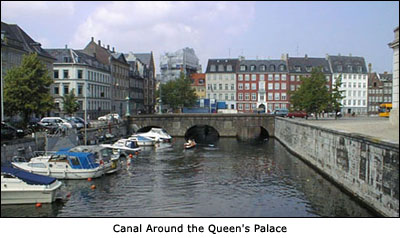
Women Artists in Scandinavia
Just across the street, a poster caught our attention. It was opening day of an exhibit, "Women Painters in Scandinavia 1880-1900." Later we learned it was part of Copenhagen's "Golden Days" festival, celebrating the culture of Copenhagen at the dawn of modern Europe. That was a period of great change, improved economics, and new freedom of expression in the arts.
What a treat to explore this exhibit of fantastic paintings, and learn about the lives of women in Scandinavia – both the artists and the subjects – at that culturally vibrant time. Many women artists were breaking new ground, painting real life activities – not just still life or portraits – from a woman's perspective.
These women were gaining recognition and acceptance as "professional painters" and even traveling to distant places (without a man) to paint landscapes and people. This exhibit was a favorite for us, and we're hoping to pass through Copenhagen again, just to see the exhibit once more.
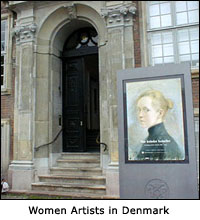 |
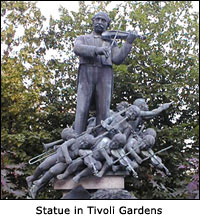 |
Tivoli Amusement Gardens
Tivoli Gardens, Denmark's oldest amusement park, sits right in the middle of Copenhagen. We wandered through this delightful, but crowded park with Ferris wheels, merry-go-rounds, ice cream vendors and restaurants. Art was everywhere. The violin children (or are they angels) above seem to be swaying to the music they are creating with their teacher. We watched a puppet show, wandered around the grounds, then waited for the parade of marching soldiers and the miniature "Queen's Carriage" to pass by before we headed back to the train station. It had been quite a day!
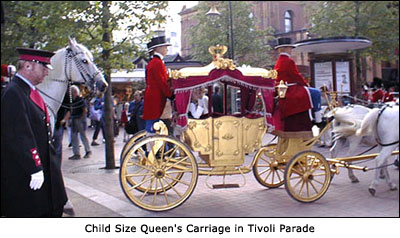
Dipping into Danish Prehistory
The next day was a Sunday, and we had decided to get an early start and visit the National Museum on our way out of town. Everyone must have been sleeping in because we had our choice of parking spots and were the first ones in the door at 9:00 AM. This vast museum contains thousands of artifacts from the Paleolithic period to the 19th century. We decided to narrow our focus just a bit and headed for the "Danish Prehistory" section.
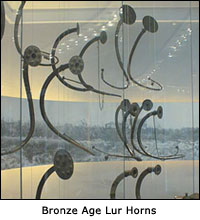 |
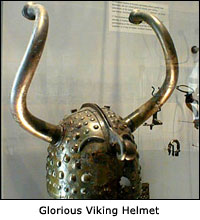 |
It was mind boggling as we looked at rune stones, Viking armor, old coins and our favorites, these ancient lurs, sacred musical instruments from the Bronze age. Thirty of these lurs have been found in Denmark (buried in bogs) and almost all of them are in this museum. And amazingly these 3,000 year old instruments can still be played. We loved the beautiful way objects were displayed in the museum. Here a Viking helmet shines with pride and power. We scooted out of the museum just as a tour bus arrived and headed out to explore the Danish countryside.
| Veggie Gram Menu |